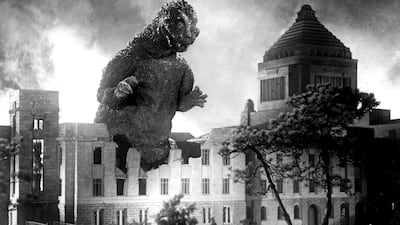Godzilla – featuring a giant reptile born in a post-war Japan traumatised by Hiroshima – gets eye-popping special effects in its latest Hollywood remake, combined with a reflection on the nuclear threat.
The mutated monster, the rights for whom are still owned by the Japanese studio Toho, was already adapted by Hollywood in 1998, with German disaster-movie director Roland Emmerich at the helm.
For the new version, out today, the Hollywood giant Warner Bros put Godzilla’s fate in the hands of the Briton Gareth Edwards, who made the independent sci-fi flick Monsters (2010).
A fan of the original 1954 Godzilla by Ishirô Honda, the director recalled in a recent round table with reporters that the film – which celebrates its 60th anniversary this year – was “plainly a metaphor for Hiroshima and Nagasaki”.
“I think that’s why it stood the test of time, cause it’s got some meat on the bone,” he added.
Since 1954, Toho has produced no fewer than 28 Godzilla films, mostly with modest special effects, and B-movie scripts and tone.
The Warner Bros version is vastly more ambitious. Along with cutting-edge computer-generated imagery (CGI), it is "probably a lot more character-driven than normal Godzilla movies," said Edwards.
Faithful to the original, the movie opens in Japan where Joe Brody (played by the Breaking Bad star Bryan Cranston) sees his wife Sandra (played by Juliette Binoche) die in the nuclear power plant where they work, after a serious accident.
Years later, Brody is still trying to find out what caused the catastrophe, risking his life. His son Ford (Aaron Taylor-Johnson), an American soldier, tries to persuade him to let go. But the appearance of Godzilla and two other out-of-control monsters changes the course of events dramatically.
In the 1954 original, Godzilla embodied the monstrous consequences of the use of atomic bombs. A 1956 version, Godzilla: King of the Monsters!, brought the story to the US and other non-Japanese markets.
Sixty years later, the atomic fire still blazes inside the beast, a deliberate choice in a screenplay that was being written just as the earthquake-tsunami-nuclear meltdown occurred in Fukushima in March 2011.
The narrative of the film is carried by Taylor-Johnson and Elizabeth Olsen (his on-screen wife), who are both making their debuts in a big-budget blockbuster, after making their names in independent cinema.
"I wanted a change," Olsen said. Her partner, whose credits include Oliver Stone's 2012 thriller Savages, gained 10 kilograms of muscle to play his soldier role.
For the producer Thomas Tull, a monster fan whose past work includes last year's Pacific Rim, making a new Godzilla was a childhood dream come true.
“Godzilla represents a force of nature,” Tull said. “Not only is he huge in size, but also he’s a walking nuclear reactor, he has atomic breath, so it’s tough to beat that. I also think that just globally, everybody knows Godzilla. They know the roar, what he looks like. He’s become a cultural global icon.”

